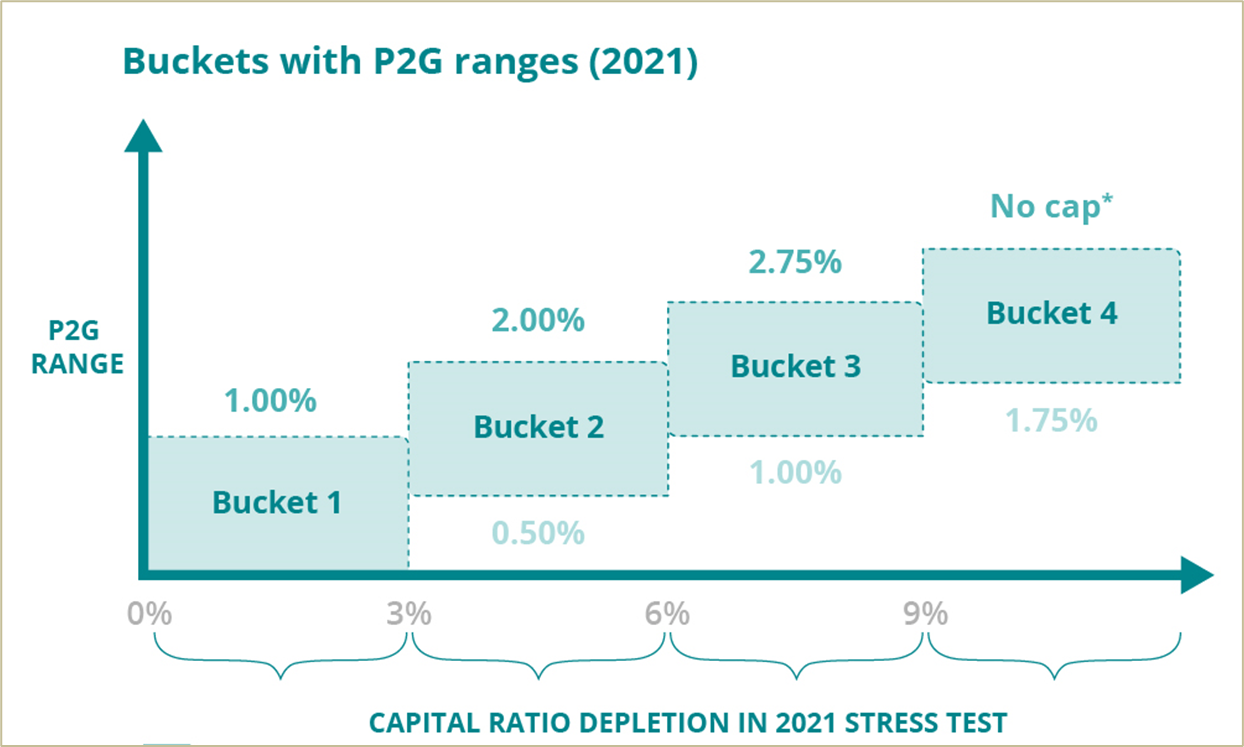- SUPERVISION NEWSLETTER
Capital: ECB revisiting approach to Pillar 2 guidance
18 August 2021
Every bank under European banking supervision must maintain a certain level of capital, known as the minimum capital requirements (Pillar 1 and Pillar 2 requirements). On top of these requirements, banks are also asked to maintain an extra capital buffer, called Pillar 2 guidance (P2G). All these capital levels are set in the annual Supervisory Review and Evaluation Process (SREP). As of the 2021 SREP cycle, ECB Banking Supervision is applying a new methodology to determine the P2G, following legislative updates to the Capital Requirements Regulation and the Capital Requirements Directive.
Unlike the Pillar 1 and Pillar 2 requirements, the P2G is a non-binding supervisory recommendation. It tells banks how much capital they are expected to maintain to be able to withstand situations of severe financial stress. Accordingly, the P2G is set based on supervisory stress tests. The stress test results are reflected in the SREP in two ways. Supervisors take account of certain qualitative outcomes when assessing banks’ governance and risk management, such as the quality and timeliness of data. At the same time, they use the quantitative impact of the adverse stress test scenario on banks’ capital ratios as a key input to determine the level of P2G.
Setting the P2G for each bank is a two-step process based on a “bucketing” framework.
- First, banks examined in the European Banking Authority (EBA) and ECB Banking Supervision stress test exercises are allocated to one of four predefined P2G buckets depending on how much their fully loaded Common Equity Tier 1 (CET1) capital was depleted in the adverse scenario of the stress tests. For banks not covered by the stress test exercises, supervisors determine the P2G based on a forward-looking assessment of risks to the banks’ capital. Each bucket has a corresponding range of P2G, which overlaps with neighbouring buckets to avoid cliff effects.
- Second, supervisors apply supervisory judgement to determine a bank’s final P2G within the ranges of each bucket, and exceptionally beyond them. This process is bank-specific, as supervisors take a bank’s risk profile and its stress test-based capital projection into account.
Chart 1
Pillar 2 capital guidance is determined by supervisors based on a “bucketing” framework

Source: ECB Banking Supervision.
Note: (*) Maximum P2G in 2021 is expected to be 4.5%.
The P2G ranges are designed to reflect an adequate level of capital based on recent supervisory experience, ECB Banking Supervision’s risk tolerance and the severity of the stress test scenarios. With the revised P2G methodology, ECB Banking Supervision aims to strengthen the link between the P2G and the stress test results while focusing on CET1 capital, a bank’s highest quality capital. The methodology is simple in design yet ensures a level playing field and consistency. An individual bank’s P2G cannot be inferred solely from how much of its capital was depleted in the stress test, but these details on the new P2G methodology should enable a better understanding of how the stress test results are used within the SREP. In addition, the new methodology provides a reasonable P2G, both for banks with low capital depletion and those with high capital depletion. For instance, ECB Banking Supervision currently does not expect to assign a P2G higher than 4.5% to any bank.
While the revised P2G approach was applied this year to make full use of the 2021 stress test and related capital impact simulations, it does not affect the ECB’s commitment to allow banks to operate below the P2G and the combined buffer requirement until at least the end of 2022, as clarified in July 2020. This leeway should continue to provide temporary capital and operational relief to banks during the coronavirus pandemic, enabling them to absorb losses and support the economy by providing credit to households, small businesses and corporates.
Evropská centrální banka
Generální ředitelství pro komunikaci
- Sonnemannstrasse 20
- 60314 Frankfurt am Main, Německo
- +49 69 1344 7455
- media@ecb.europa.eu
Reprodukce je povolena pouze s uvedením zdroje.
Kontakty pro média

